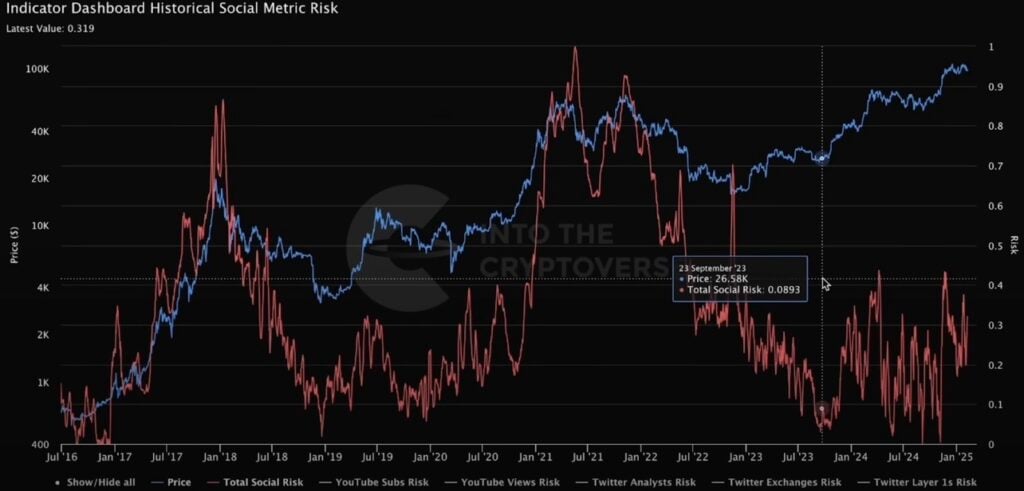News and Analysis on Cryptocurrencies, Blockchain and Decentralized Finance
Most crypto traders have been eagerly anticipating what in the crypto world is referred to as altcoin season or “alt season” for short: that insane period when altcoins achieve incredible gains and go parabolic. So many have repeatedly called for its arrival, only to be proven wrong time and again. Instead of the expected surge in altcoins, Bitcoin dominance has continued to rise throughout the current market cycle.
In a recent video, well-known YouTuber analyst Benjamin Cowen examines why alt season has remained elusive and presents the factors that he believes have contributed to this trend and what can be expected moving forward.
Understanding Alt Season
Before diving into why alt season has not occurred, it is important to define what alt season actually means. While some investors may feel that small rallies in altcoins constitute an alt season, true alt season is marked by a sharp decline in Bitcoin dominance alongside significant gains in altcoin-to-USD pairs.
Historical data shows that there were two clear alt seasons in previous market cycles: one in 2017 and another in 2021. During these periods, Bitcoin dominance collapsed, and altcoins experienced explosive growth. However, outside of these moments, Bitcoin dominance has generally trended upward or remained stable, meaning that altcoin gains have been limited compared to Bitcoin’s performance.
The current market, however, does not resemble the alt seasons of the past. Since 2022, Bitcoin dominance has steadily increased, and altcoin performance relative to Bitcoin has continued to deteriorate. This has led many to question why alt season has not materialized.
Why Have Calls for Alt Season Been Wrong?
There are several reasons why analysts and influencers have consistently misjudged the arrival of alt season.
1. The Desire for Quick Profits
Many investors enter the cryptocurrency market looking for rapid gains. Altcoins have historically offered greater potential for outsized returns compared to Bitcoin, leading to frequent speculation that an alt season is just around the corner. However, in reality, Bitcoin has been the more stable and lucrative investment over the past few years, offering consistent gains with lower risk.
For traditional investors, a 6X return in two years would be considered extraordinary. Bitcoin has achieved this level of growth from its bottom, yet some investors remain unsatisfied and continue chasing higher-risk altcoins in the hopes of achieving even greater returns. However, failing to recognize the absence of alt season has led to losses for many who have shifted into altcoins prematurely.
2. Bitcoin as a Safe Haven Asset
A key reason why altcoins have struggled is the importance of denominating portfolios in Bitcoin rather than USD. Instead of evaluating altcoin performance in dollar terms, seasoned investors assess them in terms of Bitcoin value. When altcoin-to-Bitcoin ratios decline, it becomes evident that holding Bitcoin is the superior strategy.
For example, in 2021 and 2022, one Bitcoin was worth approximately 11 Ethereum (ETH). Today, that same Bitcoin is worth around 36 ETH. This means that Bitcoin holders have tripled their ETH holdings simply by staying in Bitcoin rather than switching to altcoins. This trend illustrates why denominating portfolios in Bitcoin is a more effective strategy during certain market conditions.
3. The Increase in Altcoin Supply
A common argument for alt season in recent years has been the sheer number of new altcoins entering the market. Many believed that with so many new tokens being created, Bitcoin dominance would inevitably decline. However, this assumption was flawed.
While the number of altcoins has increased, the total amount of liquidity in the market has remained relatively constant. Instead of more money flowing into altcoins, the available liquidity has been spread thinner across a larger number of assets. This dilution has prevented any meaningful rise in altcoin market capitalization relative to Bitcoin.
The Role of Macro Conditions
Another crucial factor in understanding the absence of alt season is macroeconomic conditions, specifically the Federal Reserve’s monetary policy.
1. Quantitative Tightening
One of the strongest arguments against an imminent alt season is the Federal Reserve’s ongoing policy of quantitative tightening. Historically, alt season has coincided with periods of loose monetary policy, such as in 2017 and 2021 when the Fed was not actively tightening liquidity.
During those cycles, Bitcoin dominance dropped as excess liquidity in the financial system allowed investors to take on more risk, leading to increased speculation in altcoins. However, since 2022, the Fed has maintained a restrictive monetary stance, limiting risk appetite in the market. This has led to a steady decline in the performance of altcoins relative to Bitcoin.
2. The Impact on Bitcoin and Altcoins
History has shown that Bitcoin bottoms and tops often align with shifts in monetary policy. In the previous cycle, Bitcoin dominance only began to decline after the Fed ended its tightening policies. This time around, a similar trend is playing out, with Bitcoin continuing to outperform altcoins as long as tight liquidity conditions persist.
Looking at key altcoin-to-Bitcoin ratios, such as Ethereum-to-Bitcoin (ETH/BTC), we can see that altcoins have continued to lose value against Bitcoin. This reinforces the idea that until the Fed pivots away from its current policy, altcoins will likely continue to underperform.
Retail Participation and Market Sentiment
Another major factor contributing to the lack of alt season is the absence of a strong retail investor presence.
1. Social Risk Metrics

A critical element of previous alt seasons was the presence of strong retail investor engagement. This can be measured using social risk metrics, which track the level of hype and engagement in the cryptocurrency space.
In 2017 and 2021, these metrics showed sustained increases, reflecting growing retail enthusiasm. However, in the current cycle, social engagement has remained relatively muted, suggesting that the retail frenzy required to drive an alt season has not yet returned.
2. Bitcoin’s Dominance Over Other Cryptos
Retail investors often enter the market late in the cycle, buying into altcoins at the peak of hype. However, the current environment lacks the same speculative fervor seen in previous cycles.
Bitcoin is reaching new highs, but most altcoins, including Ethereum, have not yet followed suit. This divergence highlights the different market conditions compared to previous alt seasons.
What Needs to Happen for Alt Season to Start?
For alt season to truly begin, Cowen believes several key conditions need to be met:
- A Federal Reserve Pivot – The Fed needs to shift from quantitative tightening to a more accommodative monetary policy. Until liquidity conditions improve, risk appetite for altcoins will remain low.
- Bitcoin Dominance Decline – A meaningful drop in Bitcoin dominance is necessary to signal the beginning of a true alt season. So far, dominance has only increased, reinforcing Bitcoin’s strength.
- Retail Participation Surge – A return of retail enthusiasm, as measured by social risk metrics and trading volumes, would be a key indicator of an impending alt season.
- Altcoin Capitulation – Many altcoin-to-Bitcoin pairs still have room to decline before bottoming out. Historically, altcoins only begin to recover after a period of extreme capitulation.
Final Thoughts
While many have eagerly anticipated alt season, the reality is that market conditions have not yet aligned to support one. Until key macroeconomic and liquidity factors change, Bitcoin is likely to remain the strongest asset in the crypto space. Investors who have stayed in Bitcoin rather than shifting into altcoins have seen significantly better returns, and many of those who have jumped into altcoins too early have often seen poor performance.
MIND of Pepe: Where Meme Coins Meet Artificial Intelligence
MIND of Pepe is an innovative crypto project that fuses meme culture with advanced artificial intelligence (AI). At its core is an adaptive AI agent designed to continuously learn about meme coins, engage with the community, and enhance its features over time.
The project’s ecosystem is powered by its native token, $MIND, which provides holders with unique benefits, such as market insights and participation in community-driven events. Its carefully structured tokenomics, with a supply of 100,000,101,001 tokens, supports presale, liquidity, development, marketing, and staking rewards, ensuring long-term sustainability.

Security and transparency are central to MIND of Pepe’s mission. The project’s smart contracts have been audited by Coinsult, a respected blockchain security firm, with the results publicly available to reinforce trust within the community.
For those interested in the presale, MIND of Pepe offers a straightforward process with step-by-step guidance on its official website, ensuring accessibility for all potential investors. The website also includes a detailed FAQ section, clarifying common questions and explaining the project’s operations and objectives.
By merging AI technology with the entertainment value of meme coins, MIND of Pepe seeks to redefine the cryptocurrency landscape. The project’s ability to innovate continuously through its AI-driven approach creates a dynamic and engaging experience for its community. With a strong focus on both value and entertainment, MIND of Pepe positions itself as a leader in the rapidly evolving world of cryptocurrencies.
Visit the official MIND of Pepe website to learn more and participate in the presale.